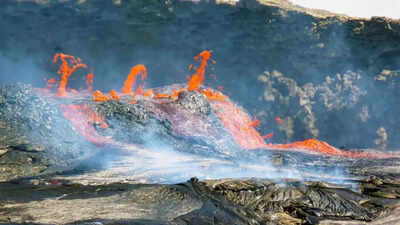In East Africa’s Afar Depression, one of the only places on Earth where three tectonic plates meet, scientists have found compelling new evidence that fresh lava from deep within the mantle is playing a key role in the continent’s gradual splitting. Recent studies reveal that mantle upwellings beneath the region are not uniform but instead pulse upward in complex waves of molten material. This geological activity is not only fueling volcanic eruptions and earthquakes but is also actively weakening the crust. Over time, this process is expected to lead to the formation of a new ocean that will one day separate the Horn of Africa from the rest of the continent, transforming the geography of the region on a monumental scale.
Lava pulses and chemical striping reveal Earth’s deep inner workings
Scientists from the University of Southampton and Swansea University analyzed lava from over 130 young volcanoes across the Afar region. Their findings showed that the mantle beneath East Africa behaves like a beating heart, with pulses of partially molten rock rising to the surface. Each pulse carries its own distinct chemical signature, indicating that the mantle is not a single plume but a patchwork of different materials. This dynamic behavior is strongly influenced by the thickness and motion of the tectonic plates above.In fast-moving zones like the Red Sea Rift, mantle flow is more focused and intense. In slower rifting regions, it spreads more gradually. These pulses travel through thinned areas of the Earth’s crust, which are more susceptible to volcanic eruptions. The chemical “striping” in the lava mirrors cardiovascular rhythms and reflects the deep Earth’s internal tempo. This provides rare insight into how volcanic activity on the surface is tied to hidden processes occurring far beneath our feet.The plume’s action is also eroding the lithosphere, Earth’s outer shell, to just 15 kilometers thick in some parts of the Afar Depression. As the plates continue to stretch and thin, they create conduits for even more lava to reach the surface, leading to cycles of volcanic eruptions and seismic activity. This process mirrors events that shaped the Atlantic Ocean millions of years ago.
A continent breaks apart and a new ocean is born
The geological activity in the Afar region is part of a larger process known as continental rifting. Here, the African, Arabian, and Somali tectonic plates are moving away from each other. The space created between them is being filled with rising magma and new crust. Over time, as this rifting continues, seawater is expected to flow in and permanently flood the region. This will create a new ocean basin, much like the Atlantic that once separated Europe and North America.The current volcanic activity is already reshaping the surface. Lava from the Erta Ale volcano blankets large parts of Ethiopia, and frequent earthquake swarms mark zones of intense tectonic stress. The Boset Volcano shows layer upon layer of volcanic deposits, illustrating the long-term accumulation of geological events driven by the mantle’s upwelling.These findings not only offer a real-time glimpse into the birth of an ocean but also have implications for understanding Earth’s climate and history. Similar mantle plumes in the past have produced massive volcanic provinces like the North Atlantic Igneous Province, which contributed to significant climate changes and possibly even mass extinctions through the release of CO₂ and sulfur dioxide.Scientists emphasize that collaboration across institutions and disciplines is essential for understanding these complex dynamics. Future research will focus on mapping mantle flows beneath other thinning tectonic plates and predicting how these deep forces shape surface geology. Ultimately, the Afar region provides a natural laboratory for observing the connection between Earth’s interior and its evolving surface in action.



Alnaya CSP LLC Reviews